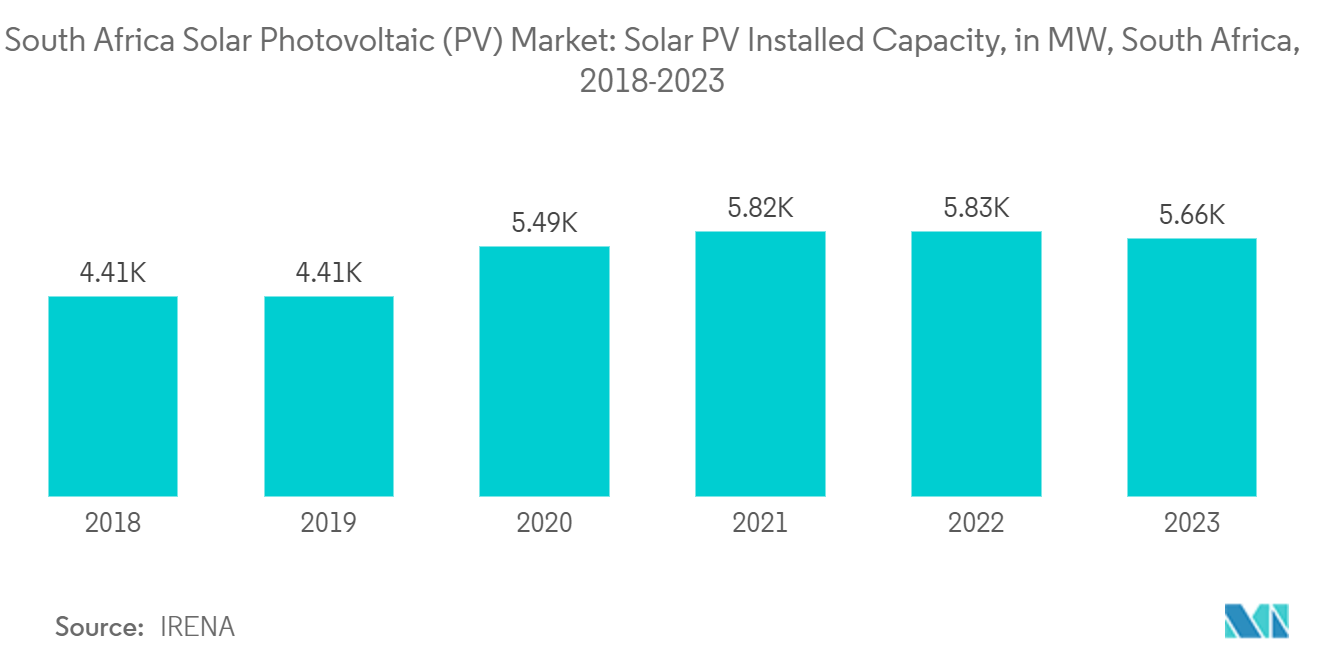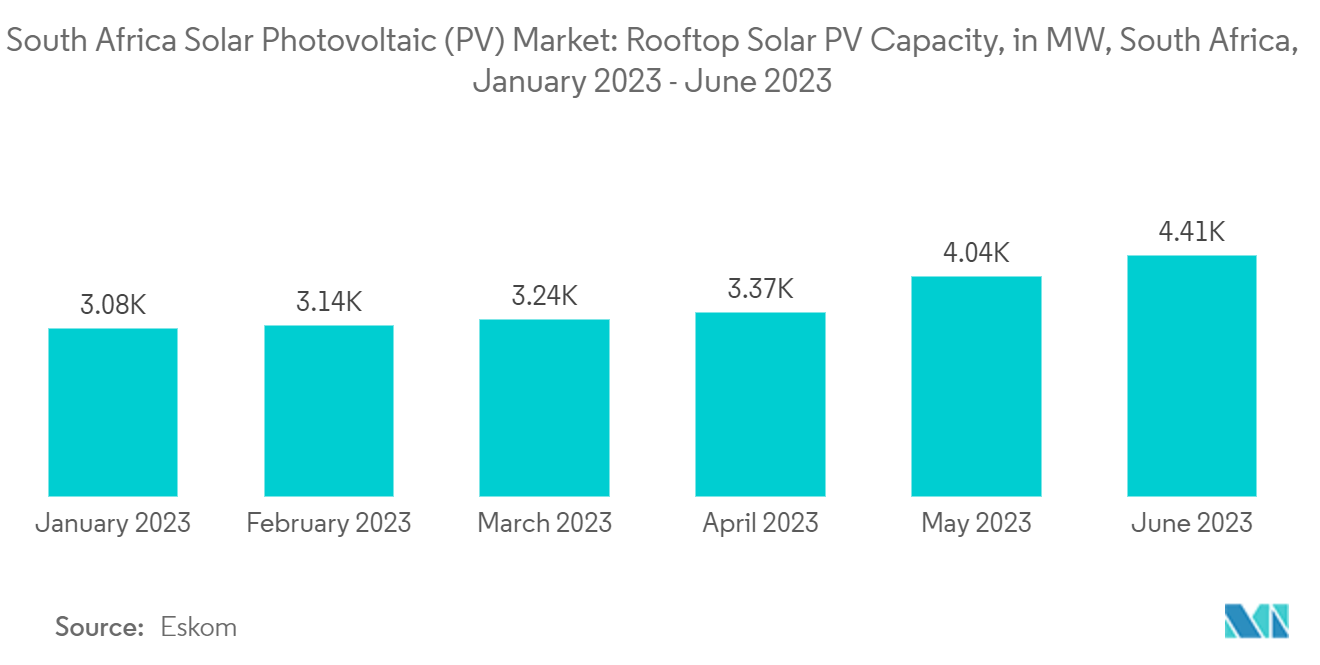Market Trends of South Africa Solar Photovoltaic (PV) Industry
The Residential Segment Expected to Witness Significant Growth
- Electricity use in most residential sectors is likely to grow in South Africa because of increasing incomes and as urban migration continues in the southern regions of Africa. Moreover, the housing sector is expected to witness considerable investment due to a population rise, rapid urbanization, and increased disposable incomes.
- According to the US Energy Information Administration (US EIA), by 2040, it is estimated that the residential sector in South Africa is likely to consume approximately 8.4 mtoe (million tonnes of oil equivalent) or 98,000 kWh of electricity.
- South Africa has great potential for renewable energy resources, especially solar and wind. The country's government is making significant efforts to increase the capacity of such sources to reduce dependency on other conventional energy sources.
- Solar photovoltaic (PV) panels are small-scale embedded generation (SSEG) panels mounted on the roof of a residential building. They convert solar energy into usable electricity. A PV system consists of solar cells connected to point them toward the sun, which an inverter then converts from direct current (DC) into usable alternating current (AC).
- According to the International Renewable Energy Agency (IRENA), as of 2023, the solar PV installed capacity in South Africa accounted for 5,664 megawatts. This represented a decrease of roughly 2.7% from the 2022. During the period under review, solar PV capacity grew dramatically from 1,064 to 5,664 megawatts in 2014 and 2023, respectively. The unstable power grid in the country is one of the reasons why residents are seeking an alternative source of electricity.
- In February 2024, in the latest development, Hohm Energy, a company that connects homeowners and businesses with accredited solar PV installers, product suppliers, and embedded solar finance in South Africa, announced raising USD 8 million in seed investment to develop residential solar rooftops in South Africa.
- In May 2024, Sungrow, the global leader in PV inverters and energy storage systems, solidified its presence in South Africa’s renewable energy sector by signing two significant agreements with ARB and Herholdt, both prestigious distributors in South Africa, as per which Sungrow is committed to providing a comprehensive range of products and services to these esteemed partners. This diverse offering comprises inverter and storage solutions for residential, commercial & industrial applications.
- Therefore, owing to the above points, the residential segment is expected to witness significant growth in the South African solar PV market during the forecast period.

Government Policies and Increasing Investments Driving the Market Demand
- Solar energy is one of the most readily accessible resources in South Africa, with an average of more than 2,500 hours of sunshine per year. The country's average solar irradiation level ranges between 4.5 and 6.5 kWh/m2 daily. The South African government has identified the significant potential of solar energy and is making efforts to increase the adoption of solar photovoltaic (PV) technology in the country's power sector.
- Due to the decreasing solar PV costs and supportive government programs from South Africa, such as the National Solar Water Heater Programme, the residential solar PV sector will increase in the country. Moreover, the Department of Mineral Resources and Energy plans to strengthen its National Electrification Programme to provide electricity access to a maximum portion of the country, which is expected to positively impact the growth of the South African residential solar PV market.
- In August 2023, Eskom published new rooftop PV installation statistics. It says that residential and C&I installations reached 4,411.5 MW of cumulative capacity by the end of June 2023, with around 1.82 GW deployed in January-June 2023 alone.
- The solar power sector was nearly nonexistent once the Renewable Energy Independent Power Producers Program (REIPPP) was introduced in 2011. However, after the program's start, the installed capacity for utility-scale solar PV reached more than 2.37 GW as of May 2022.
- Under the REIPPP, the country aims to install an 8,400 MW generation capacity of solar PV by 2030, enough to provide energy to 1.5 million households. In addition, the government plans to install 18 GW of solar PV by 2050. Such a scenario is expected to result in significant developments in the solar PV industry in South Africa.
- In April 2022, the government announced that it launched the sixth round of the Renewable Energy Independent Power Producer Procurement Programme (REIPPPP), which enables private sector investment in renewable energy development. Under this program, the authorities target procuring 2.6 GW of renewable energy, including 1.6 GW of solar PV.
- In addition, the procurement exercise is part of South Africa's plan to tender almost 12 GW of solar capacity, following the country's Integrated Resource Plan (IRP), which aims to develop up to 6 GW of new large-scale solar and 6 GW of distributed PV capacity by 2030. These initiatives will likely increase the demand for the solar PV market in the country.
- The Government of South Africa is actively encouraging the uptake of new rooftop solar photovoltaics with targeted solar policies, including a new rebate scheme announced in February 2023. The scheme allows customers to install new solar PV panels onto their homes and claim rebates equal to 1/4th of the cost of the panels. The rebate scheme started on March 1, 2023, and was set to end on February 29, 2024.
- Therefore, owing to the above points, government policies and increasing investments are expected to drive the country's solar PV market during the forecast period.


